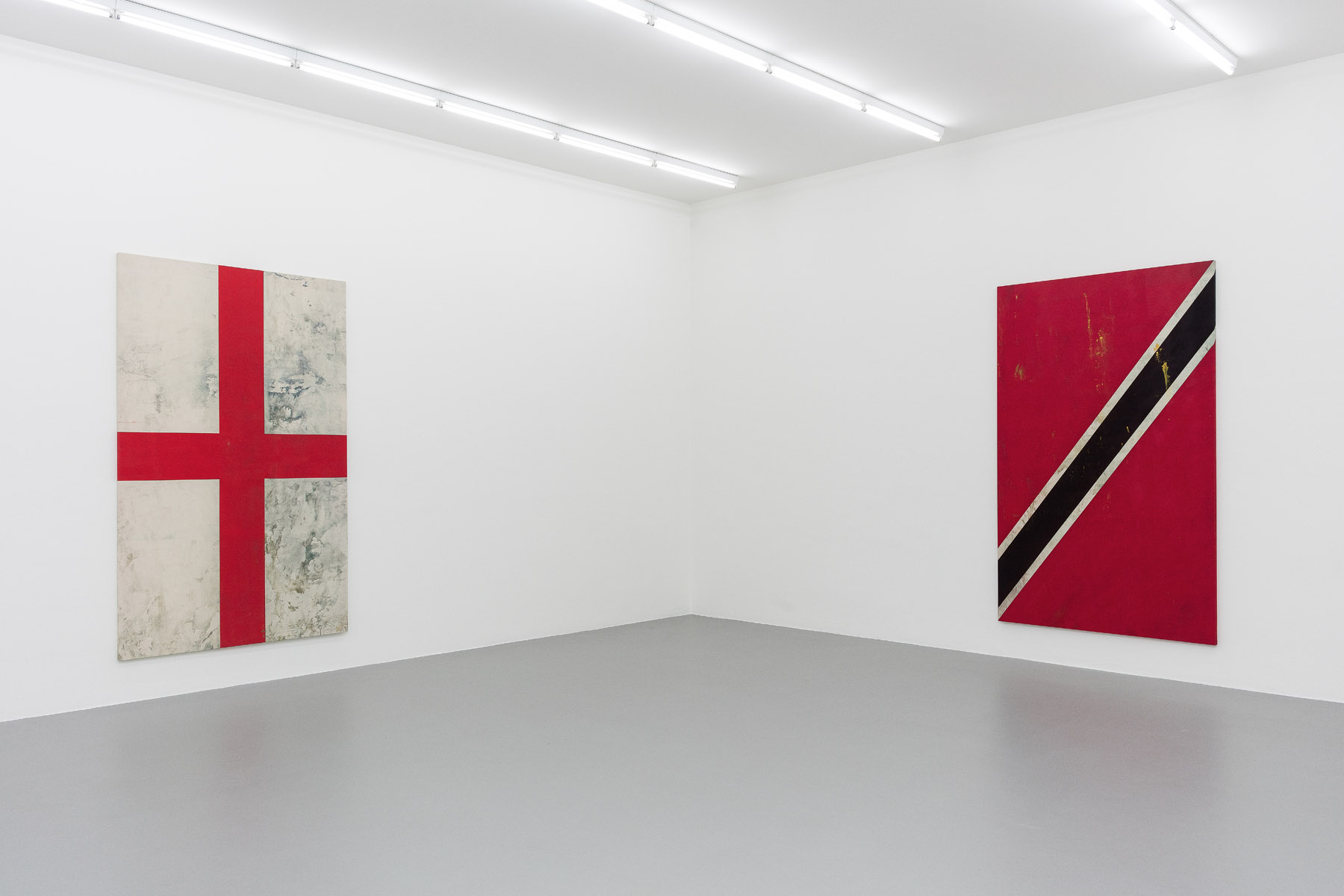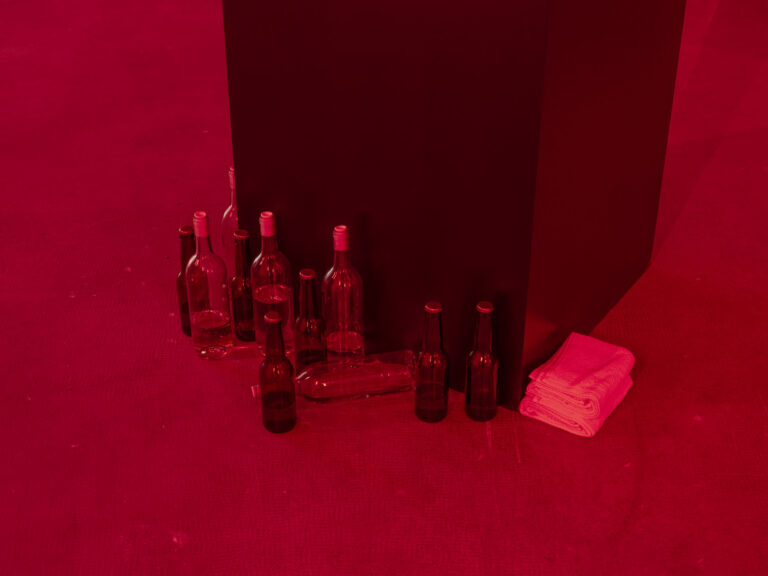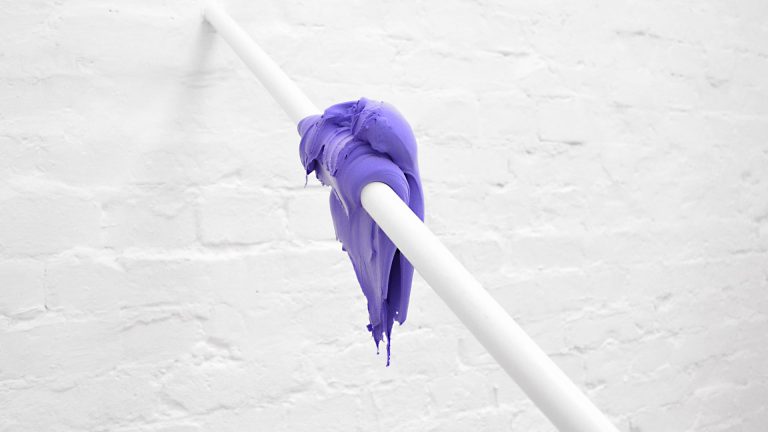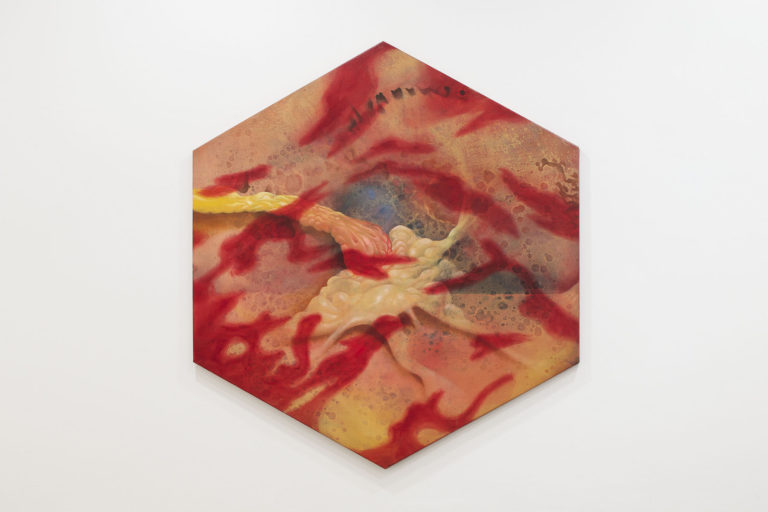Artist: Fredrik Værslev
Exhibition title: World Paintings
Venue: Giò Marconi, Milan, Italy
Date: September 22 – December 7, 2020
Photography: Filippo Armellin / images copyright and courtesy of the artist and Giò Marconi, Milan
THEY ARE THE WORLD, PART I
Dieter Roelstraete
Although the seeds for World Paintings were first planted in Fredrik Værslev’s mind back in the mid-2000s – the occasion, back then, was a chance encounter with the hard edge flag paintings of the Swedish artist Olle Baertling, billowing in the breeze outside the Moderna Museet in Stockholm – and although Værslev first started working on his “flag paintings” more than two years ago, it is hard to think of a suite of works that, in their quasi-abstract minimalist manner, more painfully and poignantly capture the singular cosmic tremors of 2020, this most horribilis of anni, especially in terms of the impact these seismic shifts have had upon the arch-global, quintessentially cosmopolitan business of contemporary art. Assembled here are twelve paintings “depicting” various countries of the world, from all five continents: Belarus (a painting executed, needless to add, long before post-electoral unrest swept the last pseudo-Stalinist dictatorship in Europe), the Turkish
Republic of Northern Cyprus (not an actual, i.e. internationally recognized state), England, Israel, Republic of Korea, Nauru, Pakistan, Panama, Seychelles, Trinidad and Tobago, and Uzbekistan. (If this seems like a disorientingly random selection – well, it is. Except for the not-so-meaningless fact, seen from both a painterly and political perspective, that all of these flags have white in them: the white, to begin with, of Værslev’s untreated canvas.) Artworks’ meanings change all the time, of course, but it is worth reflecting on the difference a mere six months makes in the conception, production and reception of these very works – Fredrik Værslev’s straight-faced, understated contribution to the long history, both hallowed and contentious, of “flag art”. At the time of writing (late August 2020), it is still not clear whether the artist will be able to travel from his native Norway to Milan for the installation and opening of his exhibition, and the same is even more doubtful with regards to the planned companion show at the artist’s gallery in New York – all because of the ongoing effects of the COVID-19 pandemic, the single most disruptive, disastrous event to befall the world economy since the Depression ninety years ago. With this particular coronavirus outbreak has come a worldwide ban on international travel, which has disproportionately impacted the contemporary art world alongside adjoining sectors of the culture and entertainment industries, the global network of higher education and research, and the like. (Our world, in other words – that of the seemingly not-so-essential services. I wrote a 10.000-word essay about Værslev’s World Paintings this past summer without ever laying eyes on the real thing – a painful, corona-enforced first, with studio visits doomed to the weightless virtuality of the FaceTime-sphere.) Indeed, although art itself, in its placeless, timeless imperviousness to cellular catastrophe, will doubtlessly weather the storm of this global health emergency without so much as a scratch – ars longa, vita brevis, right? – the same may not necessarily be said about the complex ecosystem of the contemporary art world – a “bubble” if ever there was one – which, in its historical predicament as a product of globalization, is so inextricably bound up with air travel and the constant, effortless crossing of borders by both people and things, art world denizens and artworks. Contemporary art is that quintessentially global phenomenon for which national borders and antiquated notions of nationhood or national belonging aren’t supposed to matter, except perhaps as fully historicized subject matter deserving only of patronizing archival scrutiny. But here we are, national borders and national identities fully reinforced across the European mainland, in ways not seen since the implementation of the Schengen Agreement in the mid-nineties, ushering in a new era of immobility and rootedness utterly alien to those of us – and as far as the generic addressee of this press release is concerned, that means all of us – used to years, indeed decades of frictionless flight across those old-fashioned markers of territorial belonging. Seen from this vantage point, Værslev’s World Paintings take on the elegiac tone of a (hopefully temporary) farewell to the utopian specter of art’s global village, back when the world was everyone’s oyster, the sparsely peopled gallery now a wistful memorial to a globality thrown in utter, seemingly irreversible disarray. Alternately, however, when seen from the opposing perspective of the Realpolitik of reinforced borders – for one of the great insights of the pandemic has been how easy it has proven to be to raise the notion of nationhood from the dead – World Paintings could also be read as a rumination on the persistence of national feeling, of the renewed relevance of notions of national belonging in the Brexit-Modi-Putin-Trump era, much of it so passionately expressed in people’s truly curious attachment to that most enigmatic and potent of all symbols, the flag. This, of course, shines a stark spotlight on World Paintings as a political gesture – at the expense, inevitably (such are the thermodynamics of art), of its aesthetic content, or its formal achievement. That, in a nutshell, is the problem of all “flag art”, of which Værslev must at all times have been aware – though he may perhaps not have been prepared for the radically altered conditions under which his take on flag art would have to make its first public appearance. The “problem” in question asks of us whether a painting of a flag can ever be truly a painting: can we ever see the painting, and not “just” the flag? To a certain extent, Værslev – who is keenly aware of the weight of nationhood on the international lingua franca of art, and who is definitely interested in the many conundrums raised by the return of nationalist fervor around the globe – has sought to circumvent this question by asking its unnerving inverse: can a flag ever be “just” a painting? Of course it can – of the hard-edge, minimalist variety, signaling clarity and decisiveness where none can really ever exist. Except, that is, in art.
This text was conceived as a post scriptum to a monographic essay written by the author over the course of the summer of 2020, dedicated solely to Fredrik Værslev’s World Paintings.
Fredrik Værslev, World Paintings, 2020, exhibition view, Giò Marconi, Milan
Fredrik Værslev, World Paintings, 2020, exhibition view, Giò Marconi, Milan
Fredrik Værslev, World Paintings, 2020, exhibition view, Giò Marconi, Milan
Fredrik Værslev, World Paintings, 2020, exhibition view, Giò Marconi, Milan
Fredrik Værslev, World Paintings, 2020, exhibition view, Giò Marconi, Milan
Fredrik Værslev, World Paintings, 2020, exhibition view, Giò Marconi, Milan
Fredrik Værslev, World Paintings, 2020, exhibition view, Giò Marconi, Milan
Fredrik Værslev, World Paintings, 2020, exhibition view, Giò Marconi, Milan
Fredrik Værslev, World Paintings, 2020, exhibition view, Giò Marconi, Milan
Fredrik Værslev, World Paintings, 2020, exhibition view, Giò Marconi, Milan
Fredrik Værslev, World Paintings, 2020, exhibition view, Giò Marconi, Milan
Fredrik Værslev, World Paintings, 2020, exhibition view, Giò Marconi, Milan
Fredrik Værslev, World Paintings, 2020, exhibition view, Giò Marconi, Milan
Fredrik Værslev, World Paintings, 2020, exhibition view, Giò Marconi, Milan
Fredrik Værslev, World Paintings, 2020, exhibition view, Giò Marconi, Milan
Fredrik Værslev, World Paintings, 2020, exhibition view, Giò Marconi, Milan
Fredrik Værslev, World Paintings, 2020, exhibition view, Giò Marconi, Milan
Fredrik Værslev, World Paintings, 2020, exhibition view, Giò Marconi, Milan
Fredrik Værslev, World Paintings, 2020, exhibition view, Giò Marconi, Milan
Fredrik Værslev, World Paintings, 2020, exhibition view, Giò Marconi, Milan
Fredrik Værslev, Seychelles, 2020, Spray paint and turpentine on cotton canvas / wooden stretcher, 115 x 230 x 3.5 cm
Fredrik Værslev, Seychelles, 2020, Spray paint and turpentine on cotton canvas / wooden stretcher, 115 x 230 x 3.5 cm
Fredrik Værslev, Uzbekistan, 2020, Spray paint and turpentine on cotton canvas / wooden stretcher, 115 x 230 x 3.5 cm
Fredrik Værslev, Uzbekistan, 2020, Spray paint and turpentine on cotton canvas / wooden stretcher, 115 x 230 x 3.5 cm
Fredrik Værslev, South Korea, 2020, Spray paint and turpentine on cotton canvas / wooden stretcher, 153.5 x 230 x 3.5 cm
Fredrik Værslev, South Korea, 2020, Spray paint and turpentine on cotton canvas / wooden stretcher, 153.5 x 230 x 3.5 cm
Fredrik Værslev, England, 2020, Spray paint and turpentine on cotton canvas / wooden stretcher, 138.6 x 230.4 x 3.5 cm
Fredrik Værslev, England, 2020, Spray paint and turpentine on cotton canvas / wooden stretcher, 138.6 x 230.4 x 3.5 cm
Fredrik Værslev, Trinidad and Tobago, 2020, Spray paint and turpentine on cotton canvas / wooden stretcher, 138 x 230 x 3.5 cm
Fredrik Værslev, Trinidad and Tobago, 2020, Spray paint and turpentine on cotton canvas / wooden stretcher, 138 x 230 x 3.5 cm
Fredrik Værslev, Pakistan, 2020, Spray paint and turpentine on cotton canvas / wooden stretcher, 153.5 x 230 x 3.3 cm
Fredrik Værslev, Nauru, 2020, Spray paint and turpentine on cotton canvas / wooden stretcher, 115 x 230 x 3.5 cm
Fredrik Værslev, Nauru, 2020, Spray paint and turpentine on cotton canvas / wooden stretcher, 115 x 230 x 3.5 cm
Fredrik Værslev, Panama, 2020, Spray paint and turpentine on cotton canvas / wooden stretcher, 153.5 x 230 x 3.5 cm
Fredrik Værslev, Panama, 2020, Spray paint and turpentine on cotton canvas / wooden stretcher, 153.5 x 230 x 3.5 cm
Fredrik Værslev, Belarus, 2020, Spray paint and turpentine on cotton canvas / wooden stretcher, 115 x 230 x 3.5 cm
Fredrik Værslev, USA (#3), 2020, Spray paint and turpentine on cotton canvas / wooden stretcher, 121 x 230 x 3.5 cm
Fredrik Værslev, Turkish Republic of Northern Cyprus, 2020, Spray paint and turpentine on cotton canvas / wooden stretcher, 153.5 x 230 x 3.5 cm












































